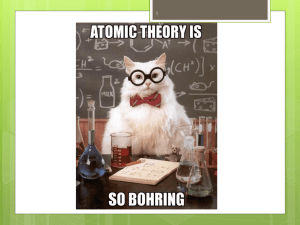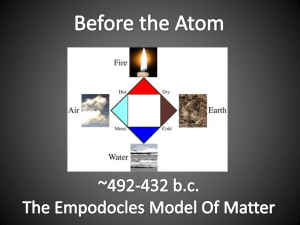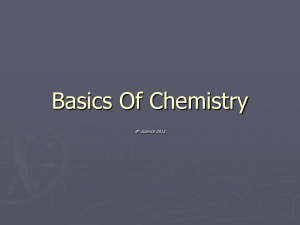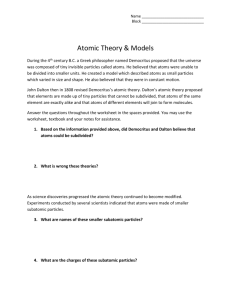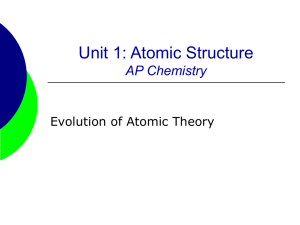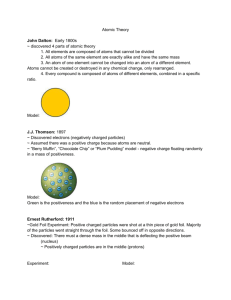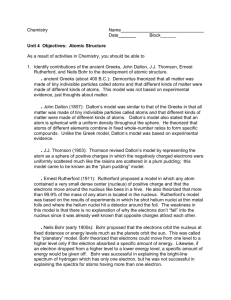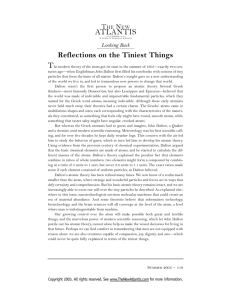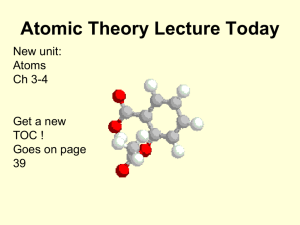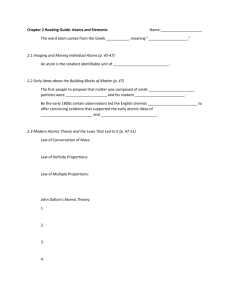Atomic Structure—Time line
advertisement
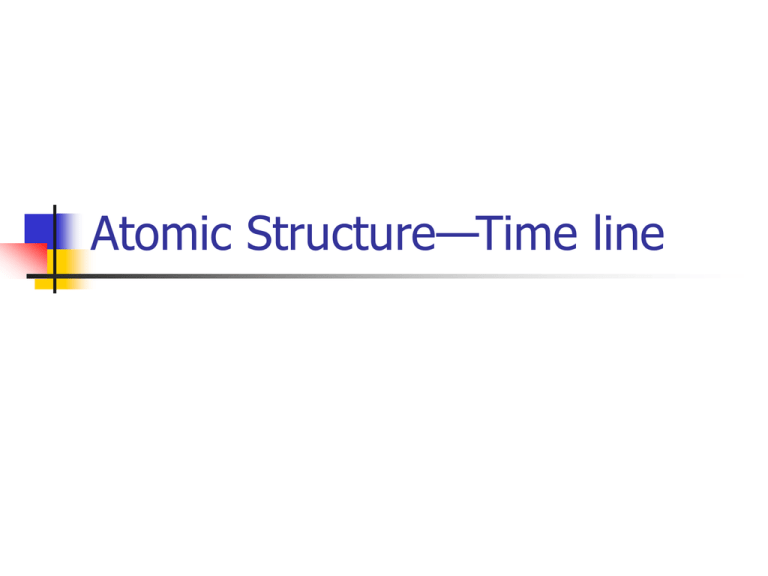
Atomic Structure—Time line B.C. Ancient Greeks: Democritus and Leucippus All matter is made up of tiny indivisible particles that could not be divided into anything smaller (atomos-atoms) Discontinuous theory Continuous theory of Matter A solid body could be divided into smaller and smaller pieces with no end. Evidence in support of the atomic theory did not come until almost 2000 years later Experiments and research 1770--Lavoisier French chemist explained the nature of burning 2Sn + O2→ 2SnO Mass of reactants: 2(119) + (32)=270 Mass of Products: 2(119+16)=2(135)=270 Mass of reactants=Mass of Products Proved the law of conservation of matter -(matter can be neither created nor destroyed) 1799--Proust French chemist devised the Law of Definite Proportions. (in a pure compound the proportion by mass of the elements is always the same) For example water—H2O 2H: 2 x 1 =2 1O: 1 x 16 =16 H:O 2:16 or 1:8 1803—Dalton English scientist devised the law of multiple proportions (certain elements often combine to form more than one compound, if the mass of one element is fixed the mass of the other element varies in a ratio of small whole numbers. For example: H2O and H2O2 In water H:O is 2:16, while in hydrogen peroxide it is 2:32. The hydrogen is fixed (2:2) while the oxygen varies (16:32 or 1:2) Try SO2 and SO3 SO2 S:O 32:32 SO3 S:O 32:48 Sulfur is fixed (32:32) Oxygen varies (32:48, 2:3) Do you see any connections between the ratios and the formulas. 1803—Dalton’s Atomic Theory (combined the above three laws into a theory) All matter is composed of very small particles called ATOMS. All atoms of the same element are exactly alike (same mass). All atoms of different elements are different (different masses). The joining of 2 or more elements in definite whole number ratios forms compounds. Modern Atomic Theory Dalton’s theory had existed for almost 100 years. As new discoveries were made Dalton’s theory had to be revised to include the structure of the atom. The major differences from Dalton include: 1. Atoms have a detailed structure that is altered during a chemical change. Atoms can be changed from one another during a nuclear change. 2. Atoms of the same element are not exactly alike they do have different masses. (isotopes) 1897—J.J. Thomson All atoms contain units of negative charge called electrons. Used a modified Crooke’s tube to show that electrons are deflected by electric and magnetic fields. Thomson Model--Plum Pudding Model— electrons embedded in a positive sphere. Atomic Structure Discovered 1909—Robert A. Millkan American scientist performed Oil-Drop experiment Determined the charge on an electron and calculated its mass. Electrons had a negative charge and a mass of 0.000548593 amu or 0 amu. 1911--Rutherford Gold-foil experiment: directed alpha particles from a polonium atom at a pieces of gold foil. Most passed through the foil without a change in direction. Concluded that most of the atom is empty space with a small, dense, positive nucleus and electrons floating around them, These positive particles with a mass of 1 amu were later known as protons. 1913—Bohr Model Bohr put electrons in energy levels like planets around the sun. 1920—Schroedinger Wave Model (Modern Atomic or Orbital Model) Electrons are not in specific energy levels, but rather in sublevels and orbitals. An orbital is the average region where an electron is most likely to be found. Forms an electron cloud. 1932—James Chadwick Discovered neutrons to have 0 charge with 1 amu. Neutrons are located in the nucleus. Summary:
